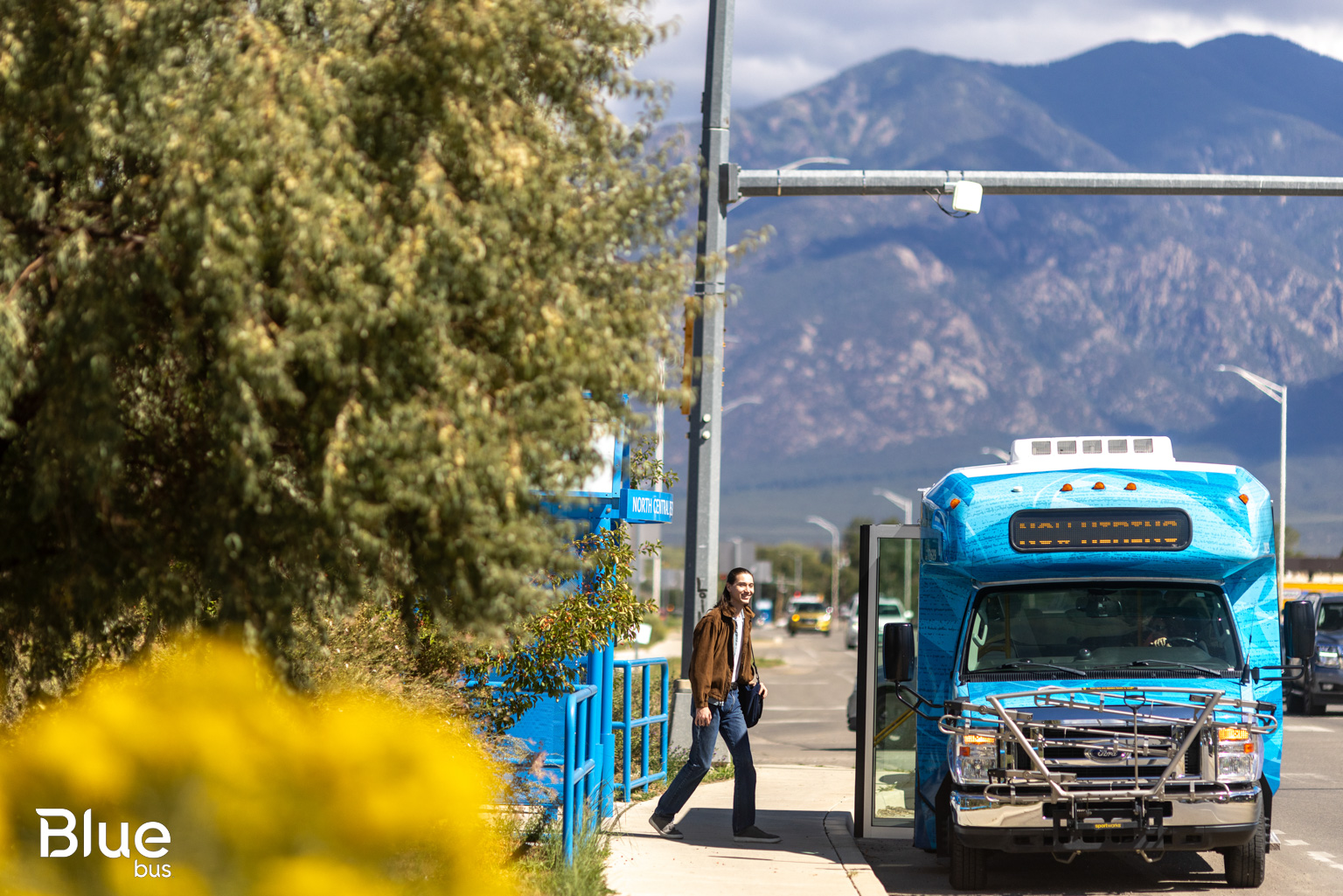
BIKES ON BUSES
All Blue Buses feature sturdy exterior racks that can hold two to seven bicycles with wheels 16″ or larger. Some buses can only hold up to three bicycles while others can hold up to seven.
Our 190 Chama, 200/300 Santa Fe/Taos and 255 Mountain Trail buses can hold up to seven bicycles.
To see if your bus will have extra bike rack space, call us at 1-866-206-0754, ext. 1.



- Walk your bike as you approach the bus stop. Stand with your bike at the bus stop until the bus comes to a complete stop.
- Secure your bike on the bus. Alert the driver before loading your bicycle on the rack. Load your bicycle onto the bike rack from the front of the bus or curb side of the bus. If the rack is empty and folded up, lower it by squeezing the handle with one hand and folding it down. If there’s already a bike on the rack, lift your bike into the available slot and place the tires into the wheel wells. Gas powered vehicles including bicycles, mopeds, scooters and Segways are not allowed on the bus.
- Unload your bike from the bus. Notify the driver when you are ready to leave. Exit using the front door of the bus and retrieve your bike. To release the bike, simply pull the support arm away from the wheel and down and lift your bike off. If the rack is empty, close it by pulling the handle and raising the rack until it locks. After unloading your bike, move towards the curb and signal the bus operator you’re done. Wait for the bus to pull away completely before starting to ride. Folding bicycles are allowed inside as long as they are kept with the passenger or stored under the seat.
More Information
- Spaces are on a first come, first served basis. There is no charge to use them.
- RTD is not responsible for personal injury, property damage or property loss arising from use of the bike racks.
- Gas powered vehicles including bicycles, mopeds, scooters and Segways are not allowed on the bus. See more information below.
- Passengers are responsible for loading, securing and unloading their bikes.
- During nonwinter service, our 255 Mountain Trail Blue Bus features sturdy exterior racks attached to the rear that can hold bicycle tire widths up to 2.8”
Bike Securement
Types of Bicycles Allowed
Standard bicycles: Bike racks are made for standard size, unaltered bikes. Conventional, single seat, two wheeled bikes are allowed to be transported on buses. Tandem, recumbent three wheeled, oversized or bikes with added accessories cannot be safely secured on the bike rack. Both wheels must fit into the bike rack wheel slots and the support arm/hook must fit over the top of the bike wheel.
Electric bicycles: Sealed dry cell, electric assist bicycles where the battery is covered and is part of the bike design are allowed on the bike rack, the bike must weigh less than 55 lbs. and be secured in the inside space nearest to the vehicle. Electric bicycles cannot be transported inside the bus. The passenger may remove the battery from the bike to secure the bike properly on our bike racks, however the battery must remain with the passenger while being transported.
Scooters: Non-motorized and small electric scooters may be brought onto the buses but must not be ridden on the bus and must not obstruct aisle ways and doorways. Passengers must secure the scooter on their person while being transported. Motorized scooters with internal combustion engines (gas powered) are not allowed on the bus.
The following bicycles are not allowed on the bike racks:
- Bikes that cannot fit into the tire slots
- Tandem bikes
- Recumbent bikes
- Tricycles
- Children’s bikes
- Gas powered bikes
- Bikes with excessive luggage attached – luggage must be removed and brought on board
- Bikes with child carriers or other equipment that could significantly obstruct the bus operator’s vision
- Bikes that cannot be secured using the installed securement system without extra measures like bungee cords
- Bikes over 55 lbs.
- Folding bikes are not allowed to be carried on the bus

